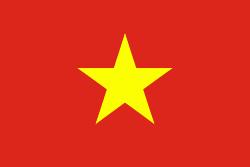Cầu Giấy District (Quận Cầu Giấy)
Cầu Giấy (lit. Paper Bridge) is an urban district of Hanoi, the capital city of Vietnam. The district currently has eight wards, covering a total area of 12.32 sqkm. It is bordered by Ba Đình district, Đống Đa district, Nam Từ Liêm district, Thanh Xuân district, Tây Hồ district, Bắc Từ Liêm district. As of 2019, there were 292,536 people residing in the district, the population density is 24,000 inhabitants per square kilometer.
The district is named after the historic bridge where the famous 19th-century Battle of Cầu Giấy (Paper Bridge) was fought.
Many new urban developments are located in Cầu Giấy. Among them, Trung Hoà - Nhân Chính is emerging as the new city's commercial center. It lies partly in the southern part of the district (Trung Hoà ward). The massive Keangnam Hanoi Landmark Tower, the tallest building in Hanoi and second tallest building in Vietnam, is also located in this area.
The district is divided into eight wards (phường):
* 1) Dịch Vọng
* 2) Dịch Vọng Hậu
* 3) Mai Dịch
* 4) Nghĩa Đô
* 5) Nghĩa Tân
* 6) Quan Hoa
The district is named after the historic bridge where the famous 19th-century Battle of Cầu Giấy (Paper Bridge) was fought.
Many new urban developments are located in Cầu Giấy. Among them, Trung Hoà - Nhân Chính is emerging as the new city's commercial center. It lies partly in the southern part of the district (Trung Hoà ward). The massive Keangnam Hanoi Landmark Tower, the tallest building in Hanoi and second tallest building in Vietnam, is also located in this area.
The district is divided into eight wards (phường):
* 1) Dịch Vọng
* 2) Dịch Vọng Hậu
* 3) Mai Dịch
* 4) Nghĩa Đô
* 5) Nghĩa Tân
* 6) Quan Hoa
Map - Cầu Giấy District (Quận Cầu Giấy)
Map
Country - Vietnam
 |
 |
| Flag of Vietnam | |
Vietnam was inhabited by the Paleolithic age, with states established in the first millennium BC on the Red River Delta in modern-day northern Vietnam. The Han dynasty annexed Northern and Central Vietnam under Chinese rule from 111 BC, until the first dynasty emerged in 939. Successive monarchical dynasties absorbed Chinese influences through Confucianism and Buddhism, and expanded southward to the Mekong Delta, conquering Champa. The Nguyễn—the last imperial dynasty—surrendered to France in 1883. Following the August Revolution, the nationalist Viet Minh under the leadership of communist revolutionary Ho Chi Minh proclaimed independence from France in 1945.
Currency / Language
| ISO | Currency | Symbol | Significant figures |
|---|---|---|---|
| VND | Vietnamese đồng | ₫ | 0 |
| ISO | Language |
|---|---|
| KM | Central Khmer language |
| ZH | Chinese language |
| EN | English language |
| FR | French language |
| VI | Vietnamese language |















